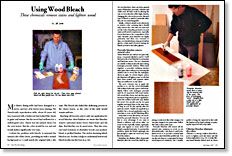
Synopsis: Jeff Jewitt explains how to use three types of bleach for specific uses; no one bleach does it all. Bleach helps match old wood to new, repair stains, remove dye, and it has other purposes. Peroxide bleaches remove natural color. Chlorine bleaches eliminate dye colors, oxalic acid works on iron stains and weathering. Jewitt addresses special staining problems, talks about how to neutralize bleach during application procedures, and explains how bleach works.
My client’s dining table had been damaged in a move, and two of its leaves were missing. The French-style reproduction table, about 60 years old, was veneered with a fruitwood that looked like cherry in grain and texture. But the wood had mellowed to a yellow-gold color. Cherry was the natural choice for the new leaves. But the color would be too red and would darken significantly over time.
I solved the problem with bleach. It removed the natural color of the cherry, providing me with a neutral background so I could match the original with a dye stain. The bleach also halted the darkening process in the cherry leaves, so the color of the table would remain uniform.
Matching old wood to new is only one application for wood bleaches. Most finishers are aware that bleaches remove unwanted stains—food, black water and old dyes. But bleaches can do much more. They also even out tonal variations in dissimilar woods and produce blond or pickled finishes. The trick is knowing which bleach to use. For that, it helps to understand how wood bleach works.
For woodworkers, there are three general types of bleaches: peroxide, chlorine and oxalic acid. All three work by altering the way wood molecules reflect light, thereby changing the color in the process. But each type of bleach is suited to particular tasks; they are not interchangeable.
Ideally, a bleach should work selectively to remove color, meaning that it should only remove the color that you want and not the color of anything around it. In most cases you’ll need to experiment, especially if you don’t know the composition of the stain. Because most bleaches are highly poisonous and often very corrosive to skin, you should always wear good rubber gloves, a dust mask (if you’re mixing dry bleach powders) and safety glasses.
Peroxide bleaches remove natural color
These bleaches are sold as two-part solutions, commonly labeled A and B. You’ll find peroxide wood bleaches in most paint and hardware stores. The two chemicals are usually sodium hydroxide and a strong hydrogen peroxide solution. When used together, a powerful oxidizing reaction takes place that is effective in removing the natural color in wood, like the mahogany shown at right. To a lesser degree, peroxide bleaches will lighten some woods that have been treated with pigment stains. They are ineffective on dye stains.
From Fine Woodworking #124
For the full article, download the PDF below:
Fine Woodworking Recommended Products

Foam Brushes

Bumblechutes Bee’Nooba Wax























Log in or create an account to post a comment.
Sign up Log in